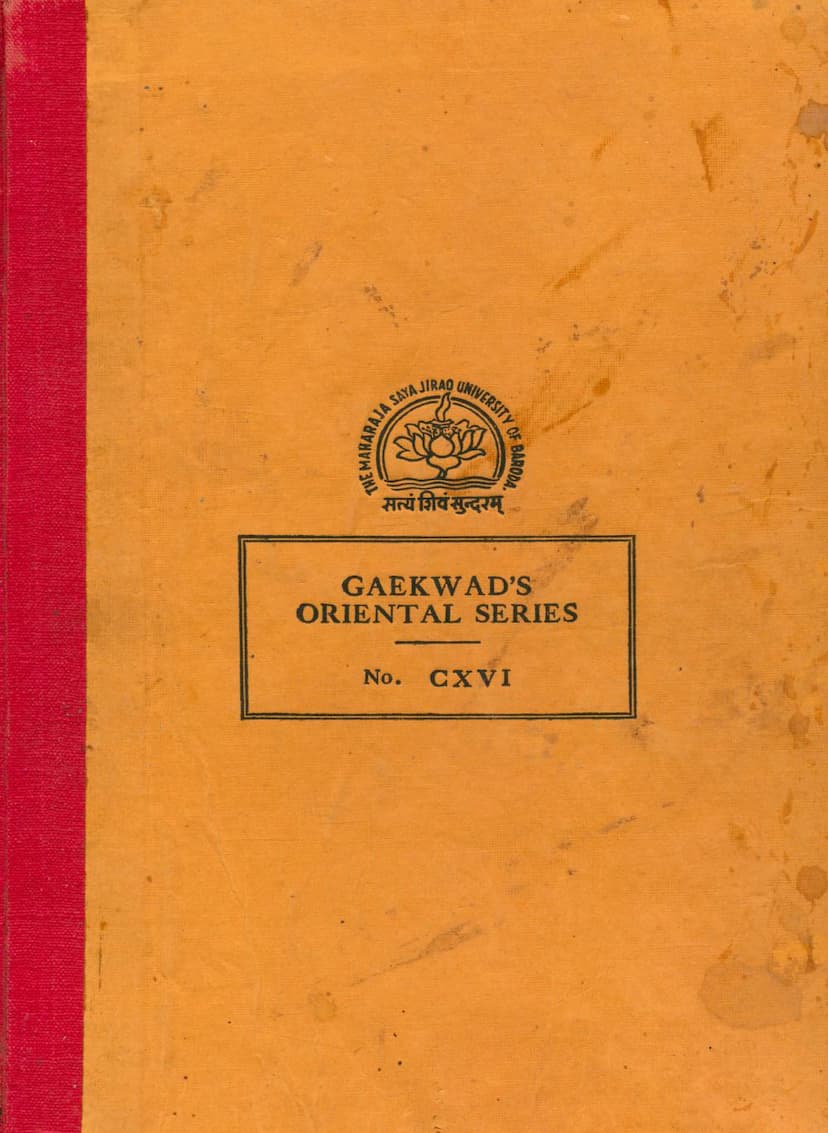Dwadashar Naychakram Part 01
Added to library: September 1, 2025

Summary
Here's a comprehensive summary of the provided Jain text, "Dwadashar Naychakram Part 01," based on the pages you've shared:
Overall Scope and Significance:
- Dwadashar Naychakram (Nayakachakra), also known as Nayachakra, is a significant Jain philosophical work by Srimallavadisuri.
- This particular volume, Part I of Four Aras, contains the first four chapters of the work, spanning pages 1-314.
- It features the commentary Nyayagamanusarini by Sri Simhasuri.
- The publication is part of the prestigious Gaekwad's Oriental Series (No. CXVI), indicating its value to the scholarly world of Indian philosophy.
- The text was edited by Late Muni Caturavijayaji (pp. 1-232) and Lalchandra B. Gandhi (pp. 233-314), with an introduction by the latter.
Key Themes and Content:
The Nayachakra is described as a "wheel of standpoints" or "wheel of concepts," advocating the Jain doctrine of Anekantavada (the many-sidedness of truth). This is achieved through the discussion of twelve Nayas (standpoints or viewpoints), each elaborated in a chapter called an Ara (spoke of a wheel).
Part I of the Nayachakra, as presented in this volume, covers the following four Aras (chapters):
-
Prathamo'ra Vidhiniyah (Vidhi Naya or Vidhi Bhangara): This chapter likely deals with the fundamental nature and purpose of the work. It defines concepts like Samanya (Generality) and Visesa (Particularity) and engages in critical analysis of philosophical views from other schools, such as the Samkhya concept of Pradhana and the Buddhist idea of Pratyaksa (Direct Perception), referencing scholars like Dignaga. It concludes the discussion on Jnanavada (Theories of Knowledge).
-
Dwitiyo'ro Vidhi-vidhi Naya: This section explores various philosophical doctrines, including:
- Apauruseyatva (Non-origination by a sentient being)
- Asatkaryavada (The effect pre-exists in the cause)
- Purusa (The Self/Soul)
- Niyati (Destiny/Fate)
- Kala (Time)
- Svabhava (Inherent nature)
- Vivarta (Transformation/Manifestation) This is highlighted as a particularly interesting discussion.
-
Tritiyo'ro Vidhi-ubhaya Naya: This chapter delves into deeper philosophical inquiries, examining:
- Purusa (The Self/Soul) and its states.
- The three qualities: Sattva, Rajas, and Tamas.
- Sukha (Happiness), Duhkha (Sorrow), and Moha (Delusion).
- Asatkaryavada (The effect does not pre-exist in the cause).
- Pradhana (The primordial matter in Samkhya).
- The concept of Karya-Karana (Cause and Effect).
- The problem of Ishvara (God) as the Creator of the world.
-
Chaturtho'ro Vidhi-niyama Naya: This chapter continues the discussion on the problem of God as the Creator of the world.
Historical and Biographical Context:
- The foreword and introduction provide crucial historical context for the work and its author.
- Mallavadi Suri is described as a prominent logician and logician, living in Valabhi, Saurashtra.
- He was an advocate of Yugapadupayogavada (a doctrine concerning simultaneous application or usage).
- The Nayachakra is considered authoritative by both Svetambara and Digambara traditions.
- The publication faced delays due to the untimely death of the initial editor, Muni Sri Caturavijayaji, at the age of 49 in 1944 AD, after 232 pages had already been printed.
- Pandit L. B. Gandhi took over the editing in 1947, completing the work from page 233 to the end of the fourth chapter. His introduction offers detailed information about the author, commentator, quoted works, and manuscript basis.
- The text is preserved within Simhasuri's commentary, and restoring the original Nayachakra text from this extensive commentary was a challenging task.
- The publication draws upon an "Arya verse," "Vidhiniyama...", which is attributed to Mallavadi and appears to be the foundation of the Nayachakra.
- The foreword meticulously traces Mallavadi's intellectual lineage, referencing earlier thinkers like Siddhasena Divakara (author of Sanmati and Nayavatara) and highlighting the influence of philosophical currents from Vedic and Buddhist literature.
- Mallavadi likely flourished in the first part of the fifth century Vikrama era, placing him after Dinnaga and suggesting a contemporary relationship with Siddhasena Divakara.
- The foreword also mentions other scholars and works that contributed to the study of Naya and Syadvada, such as Umasvati, Siddharsi, Mallisena, Haribhadra, and Devasuri.
Editorial and Publication Details:
- The publisher is the Oriental Institute, Baroda.
- The publication date is 1952.
- The price of Part I was Rs. 12-12-0.
- The general editor of the Gaekwad's Oriental Series was G. H. Bhatt.
- The foreword notes that the publication of this work inspired others to undertake similar publications, highlighting the collaborative nature of scholarly endeavors in the field.
In essence, this volume provides the foundational part of Mallavadi Suri's Nayachakra, a crucial text in Jain philosophy that systematically explores various standpoints to understand the multi-faceted nature of reality, as expounded through the lens of Anekantavada. The commentary by Simhasuri further illuminates these complex philosophical discussions. The publication itself is a testament to dedicated scholarship and the preservation of important Indian philosophical traditions.